《数字与模拟通信系统 第5版》
| 作者 | (美)(L.W.库奇)Leon W.Couch Ⅱ著 编者 |
|---|---|
| 出版 | 北京:清华大学出版社 |
| 参考页数 | 744 |
| 出版时间 | 1998(求助前请核对) 目录预览 |
| ISBN号 | 7302029458 — 求助条款 |
| PDF编号 | 86643228(仅供预览,未存储实际文件) |
| 求助格式 | 扫描PDF(若分多册发行,每次仅能受理1册) |
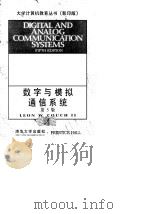
1INTRODUCTION1
1-1 Historical Perspective2
1-2 Digital and Analog Sources and Systems2
1-3 Deterministic and Random Waveforms6
1-4 Organization of This Book6
1-5 Use of a personal Computer and MATLAB7
1-6 Block Diagram of a Communication System8
1-7 Frequency Allocations9
1-8 Propagation of Electromagnetic Waves10
1-9Information Measure16
Example1-1 Evaluation of information and Entropy,17
1-10 Channel Capacity and ldeal Communication Systems18
1-11Coding19
Block Codes21
Convolutional Codes.21
Code interleaving.23
Code performance.24
Trellis-Coded Modulation.27
1-12 Preview30
1-13Study-aid Examples30
Problems31
2SIGNALS AND SPECTRA33
2-1Properties of Signals and Noise33
Physically Realizable Waveforms.34
Time Average Operator.35
Dc Value.36
Power.37
Example2-1 Evaluation of Power.38
Rms Value and Normalized Power.39
Energy and Power Waveforms.40
Decibel.40
Phasors.42
2-2Fourier Transform and Spectra43
Definition.43
Example2-2Spectrum of an Exponentiat Pulse.45
Propertise of Fourier Transforms.46
Parseval s Theorem and Energy Spectral Density.47
Example2-3Spectrum of a Damped Sinusoid.49
Dirac Data Function and Unit Step Function,50
Example2-4Spectrum of a Sinusold.52
Rectangular and Triangular-Pulses.54
Example2-5Spectrum of a Rectangular Pulse.54
Example2-6 Spectrum of a Triangular Pulse.57
Convolution.58
Example2-7Convolution of a Rectangle with an Exponential,.58
Example2-8 Spectum of a Triangular Pulse by Convotution,.59
Example2-9 Spectrum of a Switched Sinusoid.60
2-3Power Spectral Density and Autocorrelation Function62
Power Spectral Density.62
Autocotrelation Function.63
Example2-10PSD of a Sinusoid.63
2-4Orthogonal Series Representation of Signals and Noise65
Orthogonal Functions.65
Example2-11Orthogonal Complex Exponential Functions.66
Orthogonal Series.66
2-5Fourier Series68
Complex Fourier Series.68
Quadrature Fourier Series.70
Polar Fourier Series.71
Line Spectra for Periodic Waveforms.73
Example2-12Fourier Coefficienis for a Rectangular Wave,75
Power Spectral Density for Periodic Waveforms.76
Example2-13PSD for a Square Wave.77
2-6Review of Linear Systems78
linecr Time-Invariont Systems.78
Impulse Response.79
Tnmifer Fwtction.79
Example2-14RC Low-Pass Filter.81
Distortionless Transmission83
Example2-15Distortion Caused by a Filter.83
2-7Bandlimited Signals and Noise84
Bandlimited Waveforms.86
Sampling Theorem.86
Impulse Sampling.89
Dimensionolity Theorem.92
2-8Discrete Fourier Transform93
Using the DFT to Compute the Contisuous Fourier Transform.94
Example2-16DFT for a Rectangular pulse.97
Using the DFT to Compute the Fourier Series.100
Example2-17Use the DFT to Compute the Spectrum of a Sinusoid100
2-9Bandwidth of Signals101
Example2-18 Bandwidths for a BPSK Signal.105
2-10 Summary109
2-11Study-Aid Examples110
Problems113
3BASEBAND PULSE AND DIGIIAL SIGNALING127
3-1 Introduction127
3-2Pulse Amplitude Modulation128
Natural Sampling (Gating).129
Instantaneous Sampling(Flat-Top PAM).133
3-3Pulse Code Modulation136
Sampling,Quantizing,and Encoding,137
Practical PCM Circuits.140
Bandwidth of PCM.141
Effecis ofNoise143
Example3-1 Design of a PCM Systm.145
Nonuniform Quantizing:μ-Law and A-Law Companding.146
3-4Digital Signaling148
Vector Representation.150
Example3-2Vector Representation of a Binary Signal.151
Bandwidth Estimation.151
Binary Signaling.152
Example3-3Binary Signaling.153
Multilevel Signaling154
Example3-4L=4Multilevel Signal.155
3-5Line Codes and Spectra157
Binary Line Coding.157
Power Spectra for Binary Line Codes.159
Differential Coding.166
Eye Patterns.167
Regenerative Repeaters.168
Bit Synckronization.170
Power Spectra for Multilevel Signals.173
Spectral Efficiency.175
3-6Intersymbol Interference176
Nyquist s First Method(Zero ISI).179
Raised Cosine-Rolloff Filtering.180
Example3-1(contiruesd).182
Nyquist s Second and Third Methods for Courol of ISI,184
3-7 Differential Pulse Code Modulation185
3-8Delta Modulation189
Granular Noise and Slope Overload Noise.190
Example3-5Design of a DM System.191
Adaptive Delta Modulation and Continuously Variable Slope Delta Modulation.193
Speech Coding.194
3-9Time-Division Multiplexing196
Frame Synchronization.196
Synchronous and Asynchronous Lines.200
Example3-6Design of a Time-Division Multiplexer.201
TDM Hierarchy.203
The TI PCM System.205
3-10 Pulse Time Modulation:Pulse Width Modulation and Pulse Poisition Modulation209
3-11 Summary210
3-12Study-Aid Examples214
Problems217
4BANDPASS SIGNALING PRINCIPLES AND CIRCUITS226
4-1Complex Envelope Representation of Bandpass Waveforms226
Definitions:Baseband,Bandpass,and Modulation.227
Complex Eavelope Representafion.228
4-2 Representation of Modulated Signals229
4-3 Spectrum of Bandpass Signals230
4-4Evaluation of Power233
Example4-1 Amplitude-Modulated Signal.234
4-5Bandpass Filtering and Linear Distortion236
Equivatem Low-Pass Filter.236
Linear Distortion.238
4-6 Bandpass Sampling Theorem240
4-7 Received Signal Plus Noise241
4-8Classification of Filters and Amplifiers242
Filters.242
Amplifiers.246
4-9 Nonlinear Distortion247
4-10 Limiters252
4-11 Mixers.Up Converters,and Down Converters253
4-12 Frequency Multipliers259
4-13Detector Circuits261
Envelope Detector.261
Product Detector.262
Frequency Modulation Detector.264
4-14 Phase-Locked Loops and Frequency Synthesizers269
4-15 Direct Digital Synthesis276
4-16Transmitters and Receivers277
Generalized Transmitters.277
Generalized Receiver,The Superheterodyne Receiver.279
Exampl4-2AM Broadcust Superheterodyne Receiver.281
4-17 Summary283
4-18Study-Aid Examples283
Problems288
5AM,FM,AND DIGITAL MODULATED SYSTEMS295
5-1Amplitude Modulation296
Example5-1 Power of an AM Sigual.299
5-2 AM Broadcast Technical Standards301
5-3 Double-Sideband Suppressed Carrier302
5-4 Custas Loop and Squaring Loop303
5-5Asymmetric Sideband Signals304
Single Sideband.304
Vestigial Sideband.308
5-6Phase Modulation and Frequency Modulation311
Representation of PM and FM signals311
Spectra of Angle-Modulated Signals.315
Example5-2Spectrum of a PM or FM Signal with Sinusoidal Modutation.316
Narrowband Angle Modulation.321
Wideband Frequeney Modulation.322
Example5-3Spectrum for WBFM with Triangular Modulation.323
Preemphasis and Deemphasis in Angte-Modulated Systems.325
5-7 Frequency-Division Multiplexing and FM Stereo326
5-8FM and Noise Reduction Standards329
FM Broudcust Technical Standards.329
Dolby and DBX Noise Reduction Systems.329
5-9Binary Modulated Bandpass Signaling332
On-Off Keying (OOK),332
Binary-Phase Shift Keying(BPSK).336
Differential Phase-Shift Keying (DPSK).337
Frequency-Shift Keying(FSK).338
Example5-4Spectrum of the Bell-Type 103 FSK Modem.339
5-10Multilevel Modulated Bandpass Signaling345
Qundrature Phase-Shift (QPSK)Keying andM-ary Phase-Shift Keying(MPSK).345
Quadrature Amplitude Modulation(QAM),346
Power Spectral Density for Mpsk and QAM.349
5-11 Minimum-Shift Keying(MSK)352
5-12Spread Spectrum Systems357
Direct Sequence.358
Frequency Hopping.364
5-13 Summary366
5-14Study-Aid Examples366
Problems369
6RANDOM PROCESSES AND SPECTRAL ANALYSIS381
6-1Some Basic Definitions382
Random Pmcesses,382
Stationarity and Ergodicity.383
Example6-1First-Order Stationarity.383
Example6-2 Ergodic Random Process.385
Correlation Functions and Wide-Sense Stationarity.386
Complex Random Processes.390
6-2Power Spectral Density391
Definition.391
Wiener-Khintchine Theorem392
Properties of the PSD,395
Example6-3Evaluction of the PSD for a Ploar Baseband Signal.395
Generul Formula for the PSD of Digital Signals399
White Noise Processes.402
Measurement of PSD.403
6-3 De and Rms Values for Ergodic RandomProcesses404
6-4Linear Systems406
Input-Output Relationships.406
Example6-4Output Autocorrelation and PSD for an RC Low-Pass Filter,409
Example6-5 Signal-to-Noise Ratio at the Outpul of an RC Low-Pass Filter.410
6-5Bandwidth Measures411
Equivatent Bandwidth.411
Rms Bandwidth.411
Example6-6Equivalent Bandwidth and Rms Bandwidth for od RC LPF.413
6-6The Gaussian Random Process413
Propenies of Gamssion Processes.415
Example6-7White Gaussian Noise Prcess.417
6-7Bandpass Processes418
Bandpass Represemations.418
Propenies of WSS Bandpass Processes.421
Example6-8Spectra for the Quadrature Compenents of White Bandpuss Noise.424
Example6-9 PSD for a BPSK Signal,424
Proofs of Some Properties.425
Example 6-10PDF for the Envelope and Phase Functions of a Gaussion Bandpass Process.428
6-8Matched Filters430
General Results.430
Results for White Noise.433
Example6-11Integrate-and -Dump(Matched)Filter,434
Correlution Processing.437
Example6-12Matched Filter for Detection of a BPSK Signal.437
Transversal Matched Filter.438
6-9 Summary441
6-10 Appendix:Proof of Schwars s Inequality443
6-11Study-Aid Examples446
Problems448
7PERFORMANCE OF COMMUNICATION SYSTEMS CORRUPTED BY NOISE458
7-1Error Probabilities for Binay Signaling459
General Results.459
Results for Gaussion Noise.461
Resulos for White Gaussion Noise and Matched-Filter Reception.463
Results for Colored Gaussian Noise and Matched-Filter Reception,464
7-2Performance of Baseband Binary Systems465
Unipotar Signaling.465
Polar Signaling.467
Bipolar Signaling.468
7-3Noncoherent Detection of Bandpass Binary Signals470
On-Off Keying.470
Binary-Phase-Shift Keying.472
Prequener-Shift Keying.473
7-4Noncoherent Detection of Bandpass Binary Signals476
On-Off Keyign.477
Frequeney Shift Keying.480
Differential Phase-Shift Keying.482
7-5 Quadrature Phase-Shift Keying and Minimum-Shift Keying484
7-6Comparison of Digital Signaling Systems487
Bit Error Rate and Bandwidth.487
Synchrunization.489
7-7 Output Signal-to-Noise Ratio for PCM Systems490
7-8Output Signal-to-Noise Ratios for Analog Systems495
Comparison with Baseband Systems/496
AM Systems with Product Detection.497
AM Systems with Envelope Detection.498
DSB-SC Systems.499
SSB Systems.500
PM Systems.501
FM Systems.505
FM Systems with Threshold Extension508
FM Systems with Deemphasis.509
7-9Comparison of Analog Signaling Systems511
Ideal System Performance.514
7-10 Summary515
7-11Study-Aid Examples515
Problems524
8CASE STUDIES OF COMMUNICATION SYSTEMS533
8-1Telecommunication Systems534
Time-Division Multiplexing.534
Frequency-Division Multiptexing.534
8-2Telephone Systems536
Historical Basis.536
Modem Tlephone Systems and Remote Tenninals .536
8-3 Integrated Service Digital Network543
8-4 Capacities of Public Switched Telepone Networks547
8-5Satellite Communication Systems547
Digital and Analog Television Transmission551
Data and Telephone Signal Multiple Access.553
Example8-1Fixed Assigned Multiple-Access Mode Using an FDMA Format,554
Example8-2 SPADE System,555
Personal Communications via Satellite.559
8-6Link Budget Analysis560
Signal Power Received.561
Thermal Noise Soercs.563
Characterization of Noise Sources,564
Nois Characterization of Linear Devices,565
Example8-3T and F for a Transmission Line.569
Noise Characterization of Cascaded Linear Dtyices,570
Link Budget Evatuation,572
Eb/Na Link Budget for Digital Systems.574
Example8-4Link Badget Evaluation for a Television Receive Only Terminat for Satellite Signals.575
8-7Fiber Optic Systems580
Example8-5 Link Budget for a Fiber Optic System.581
8-8 Cellular Telephone Systems582
8-9Television589
Black-and-White Television.589
MTS Stereo Sound.596
Color Television.596
Standards for TV and CATV Systems.601
8-10 Summary609
8-11Study-Aid Examples609
Problems614
APPENDIX AMATHEMATICAL TECHNIQUES,IDENTTTIES, AND TABLES620
A-1Trigonomerty620
Definitions,620
Trigonometrie Identities.620
A-2Differential Calculus621
Definifion,621
Differentiation Rules,621
Derivative Table,622
A-3 Indeterminate Forms623
A-4Integral Calculus623
Definition,623
Integration Techniques,623
A-5Integral Tables623
indefinite Integrals .623
Definite Integrals,626
A-6Series Expansions627
Finite Series,627
Infinite Series,628
A-7 Hilbert Transform Pairs629
A-8The Dirac Delta Function629
Properties of Dirac Delta Function,630
A-9 Tabulation of Sa(x)=(sinx.)/x631
A-10 Tabulation of Q(z)632
APPENDIX BPROBABILITY AND RANDOM VARIABLES634
B-1 Introduction634
B-2 Sets635
B-3Probability and Relative Frequency636
Simple Probability,636
Join Probabiliry.637
ExampleB-1Evaluation of Probubilities,637
ExampleB-1 (Continued),638
Condinonat Probabilities,638
ExampleB-1(Continued),638
B-4Random Variables639
ExampleB-2 Random Variable,639
B-5Cumulative Distribution Functions and Probability Density Functions639
ExamlpeB-2 (Continued),641
Properties of CDFs and PDFs,642
Discrete and Continuous Distributions,642
ExampleB-3A Contimuous Distribution642
ExampleB-3 (Continued),644
B-6Ensemble Average and Moments646
Ensemble Average,646
ExampleB-4Evaluation of an Average,647
Moments,647
B-7Examples of Important Distributions649
Binontiol Distribution,649
Poisson Distribution,652
Uniform Distribution,652
Gaussion Distribution,653
Sinusoidal Distribution,657
B-8Functional Transformations of Random Variables658
ExampleB-5 Sinusoidal Distribution,659
ExampleB-6 PDF for the Output of a Diode Characteristic,660
B-9Multivariate Statistics663
Multivariate CDFx and PDFx,663
Bivnriate Statistics,665
Camssian Bivariate Distribution,666
Multivariate Functional Transformation,666
ExampleB-7PDF for the Sun of Two Random Variables,667
Central Limil Theorem,669
ExampleB-8PDF for the Sun of Three independent Uniformtly Disiributed Random Variables,669
Problems670
APPENDIX CSTANDARDS AND TERMINOLOGY FOR COMPUTER COMMUNICATIONS677
C-1Codes677
Baudot,677
ASCII,678
C-2DTE/DCE and Ethernet Interface Standards678
Current Loop,680
Rs-232C,RS-422A,RS-449,and RS-530 interfaces,680
Centronics Parallel Interface,681
IEEE-488Interface,681
Ethernet(IEEE802.3)Interface,684
C-3 The ISO OSI Network Model686
C-4Data Link Control Protocols690
BISYNC.690
SDLC.690
HDLC.690
CCITTX.25 Protocol,691
Asynchronous Transfer Mode (ATM),692
C-5 Modem Standards693
C-6 Brief Computer Communications Glossary698
REFERENCES703
ANSWERS TO SELECTED PROBLEMS714
INDEX720
1998《数字与模拟通信系统 第5版》由于是年代较久的资料都绝版了,几乎不可能购买到实物。如果大家为了学习确实需要,可向博主求助其电子版PDF文件(由(美)(L.W.库奇)Leon W.Couch Ⅱ著 1998 北京:清华大学出版社 出版的版本) 。对合法合规的求助,我会当即受理并将下载地址发送给你。
高度相关资料
-
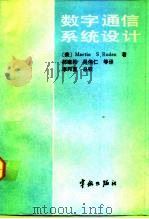
- 数字通信系统设计
- 1992 北京:宇航出版社
-
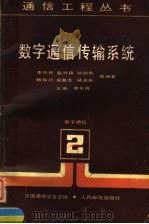
- 数字通信传输系统
- 1986年10月第1版 人民邮电出版社
-
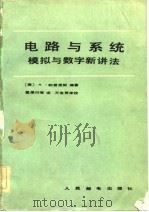
- 电路与系统模拟与数字新讲法
- 1983年06月第1版 人民邮电出版社
-
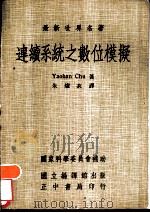
- 连续系统之数位模拟
- 1974 国立编译馆
-
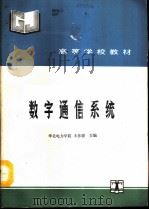
- 数字通信系统
- 1993 北京:水利电力出版社
-

- 人体工程学
- 1980 兰州:甘肃人民出版社
-

- 微电子学 数字和模拟电路系统
- 1982 北京:人民教育出版社
-

- 数字光纤通信系统原理
- 1984 北京:科学出版社
-

- 数字微波通信系统
- 1988 北京:国防工业出版社
-
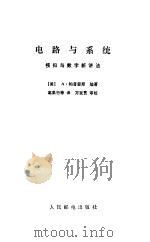
- 电路与系统 模拟与数字新讲法
- 1983 北京:人民邮电出版社
-
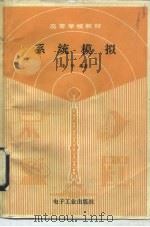
- 系统模拟
- 1990 北京:电子工业出版社
-

- 电力系统的数学模拟
- 1965 北京:中国工业出版社
-
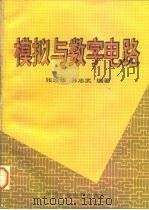
- 模拟与数字电路
- 1994 北京:中国广播电视出版社
提示:百度云已更名为百度网盘(百度盘),天翼云盘、微盘下载地址……暂未提供。➥ PDF文字可复制化或转WORD

